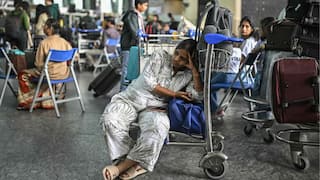Explorer
Decoding Heartland Mandate: Ganga shows the way in UP

Representational Picture (AFP)
Being the largest State in terms of population and second largest in terms of area, different regions in Uttar Pradesh have their own issues, social complexities and political preferences. So, for example, while sugarcane support price might be a big concern in Western UP, the absolute lack of physical infrastructure is probably the chief concern in Bundelkhand. Adding to the regional, linguistic and economic differences is the changing caste conundrum. Such a complex scenario can make it difficult for an observer to pick precise political trends for the state as a whole.
However, for a state broadly divided, for the sake of convenient political understanding, into West UP, Rohilkhand, Poorvanchal, Awadh, Terai and Bundelkhand, there is one belt which could help us comprehensively understand the pan UP phenomenon from West to East. It is the Ganga belt.
Entering UP from Muzaffarnagar and Bijnor in North West, traversing throughUpper Doab and lower Doab, joining Yamuna at Allahabad and leaving UP at Varanasi, Ghazipur and Ballia in the East, Ganga traverses or touches the boundaries of some 28 districts. These 28 districts in the Ganga belt account for around 170 assembly constituencies.
The results in this belt, for the last four elections, have reflected an amazingly accurate picture of the larger mandate in the state.
For instance, in 2002 when the results threw up a hung assembly in which Samajwadi Party was the single largest Party with 143 seats, Ganga belt returned 68 SP MLAs from these 170 constituencies. In 2007, the Bahujan Samaj Party won 92 seats in this belt helping Mayawati’s crowning as Chief Minister. In 2012, SP won 104 of these seats while the BJP and the BSP bagged 25 and 17 seats respectively. In 2014 Lok Sabhaelections, the BJP led in 142 of these 170 assembly segments.
The significance of this region also lies in the shifting OBC vote bank which has turned fortunes in favour of different Parties in different elections. The Nishads, Keoris, Mauryas, Mallahs, Kewats and Binds which go as a largely homogenous grouping are to be found in this belt. The other electorally significant OBC castes - Kurmis, Patels and Rajbhars also habitate the Ganga kachhar (low lands) around lower Doab and beyond it. It is at East end of the Ganga Belt that Anupriya Patel’s Apna Daland former BSP Leader Om Prakash Rajbhar’s SuheldevBharatiya Samaj Party have become significant players.
More than half of the 13 seats won by Apna Dal and SBSP come from Ganga belt. The success of this alliance is reflected in the huge margins with which some Apna Dal candidates have won. While Party candidates Neel Ratan Singh Patel from Sevapuri in Varanasi, Rahul Prakash from Chhanbe in Varanasi and Jay Kumar Singh from Jehanabad in Fatehpur have won by more than 50,000 votes over their nearest rivals, Dr D K Verma from Vishwanathganj and Sangam Lal Gupta from Pratapgarh Sadarhave won by 23000 and 28000 votes respectively. The Hindu consolidation of votes, besides benefitting BJP, has clearly enabled these two parties to punch way above their weight.
The course of Ganga is also home to some of the largest cities in UP and Kanpur (Urban), Allahabad and Varanasi Districts alone send 30 MLAs to UP assembly. In 2012 in the three districts while the BJP won 7 seats, BSP won 5, Congress - 3 and ApnaDal - 1, Samajwadi Party bagged the Lion’s share of 14 seats. In 2017, BJP and its allies Apna Dal and SBSP won 24 seatsleaving SP with 3, Congress with 1 and BSP with only 2 seats. The results were very much in tune with leads in 2014 Lok Sabha elections where BJP led in 25 assembly segments in these three Districts.
The striking departure in electorate’s mood from 2014 LokSabha elections onwards, is most visible in Allahabad. Until 2012, politics in Allahabad had become completely bipolar between SP and BSP. While in 2002, BSP won eight out of 12 seats in Allahabad District, SP reversed the tally with an identical number in 2007. In 2012, SP repeated its performance by winning eight seats once again leaving BSP contended with 3 seats while Congress got one MLA elected from Allahabad North.
The faithfulness with which the Ganga belt has reported changing political trends in UP should serve as a useful model for the Delhi media which has fumbled so often in gauging voters’ mood. So next time, if the media folks from Delhi covering UP elections want to escape the ignominy of ignorance, they would do well to start their reporting by taking a dip at the Shivalik foothills and attending Ganga Aarati at Varanasi.
(Vikas Saraswat is an entrepreneur and writer.)
(The writer tweets @VikasSaraswat)
Follow Blog News on ABP Live for more latest stories and trending topics. Watch breaking news and top headlines online on ABP News LIVE TV
View More


























